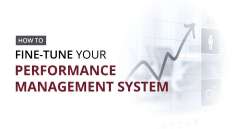The consultant asked the worker what he was doing. “Reading the newspaper,” he replied. The consultant scribbled on his clipboard. He then asked the second worker what he was doing. The second worker also replied that he was reading the newspaper. The consultant, after scribbling on his clipboard, paused, looked up and said: “I think we have a case of job duplication here, one of you will have to go.
Do you struggle to control the delivery of measurable results by the people that you lead? Wouldn't it be great if they stopped micromanaging each other, and were more empowered and engaged, and less apathetic? What do they want? Why haven't we totally solved this problem yet?
Every person in an organization is employed to deliver results (outputs) that contribute to the organization as a whole. Effectiveness is judged by the extent to which internal and external customer demands for outputs are met. In the long run, everyone is measured against whether the customers’ demands and their many and varied expectations for outputs have been satisfied.
The people who place expectations for outputs are customers, consumers, or users. Customers can demand tangible and visible products like processed milk, beer or pencils, as well as intangibles like ideas, advice or services. Customers may include shareholders, the board of directors, team members, other managers, and yourself, as well as external customers.
While the interests of customers are important, consideration also needs to be given to the expectations and demands of other groups of people, whose needs must also be satisfied, including suppliers, government and the general community. To optimize the organization system there needs to be an emphasis on the rigorously measured demands and expectations of all stakeholders. Organizational performance is judged by the extent to which stakeholder demands for outputs are met.
If we were to identify all our relevant stakeholders and customers, whether internal or external and measure their degree of satisfaction with the output or service they require in terms of quantity, quality, cost, and timeliness, then we could identify any variation that occurs in the delivery of those outputs. If we can measure and identify variation then we can control it. If we can control variation in the delivery of all the aspects of the output or service that our customers require of us, then we can improve. If we improve continuously we can stay in business and prosper.
If we were able to connect our performance measures hierarchically and even mathematically to an overall strategic plan so that each individual and team knew measurably and precisely what results were expected of them by their customers, then we could provide total stakeholder satisfaction and we would prosper.
Most performance management systems fail because they do not make the crucial link between strategy and daily actions and operations. They focus attention on tactical feedback and control of short-term operations. A good performance management system provides a comprehensive framework that translates an organization’s vision and strategy into a coherent set of outputs, performance measures and targets. By developing a set of outputs, measures, targets and feedback systems for the leadership team, and then cascading these down the organization in such a way that they are localized, meaningful, understood, owned and aligned, the link between the organization’s strategic goals and the daily actions of the people doing the work can be made.
Resource allocations, annual budgets, and strategic decisions can be driven by the strategy. Performance reviews can be used to monitor individual performance which in turn monitors organizational performance. Reward systems can be designed to reward organizational performance achievement. The vital link between what people are doing on a daily basis and strategic goals can be made.
A good performance management system must mobilize the people in the organization in such a way that their daily activities bring them closer and closer to strategic goal achievement. The performance management system must be a systematic process to implement the strategy.
Empowerment is the creation of an organizational culture in which all employees use as much of their ability as possible, in a unified and synergistic way, so as to produce the results required by internal and external customers and stakeholders. In order to clarify the notion of empowerment, we need to draw a distinction between what has to be done and how it is to be achieved.
What has to be done is determined in consultation with the stakeholders and customers, who may be internal or external. This is done by clarifying exactly what outputs are required, how those outputs are to be measured, and what targets or standards are acceptable.
How best to achieve these outputs should be left to the experts, who we define as ‘the people doing the job’. As the old saying suggests, If you want to know the road up a mountain, ask the man who walks it every day.
If outputs, measures, and targets are clarified at all levels of the organization, if each individual and the team to which she/he belongs knows exactly what is expected, then, and only then, is everyone empowered. Empowerment exists because the targets and standards form parameters within which people can exercise authority, make decisions, solve problems, communicate, utilize resources and generally implement solutions.
This is exactly the way organizations are run at the upper management levels. Similar systems, including systems of measurement, should be created with the same degree of empowerment for workers and workforce teams, for those who are in the front lines dealing with customers, for those who are adding value in the manufacturing plant. Doing so will create an environment in which the energy released from unlocking human potential can be harnessed and focused.
Everyone in the organization should understand, at the very minimum, why the system is being implemented, and how their local outputs, measures, and targets fit in with and contribute to the achievement of the organization’s goals. Understanding the connection between each individual’s targets and those of the organization helps people feel a connection; like their personal contribution is value-adding and actually making a difference to the organization. This is the best thing you can do to get people to buy into the system.
When people understand that the achievement of their personal targets is so critical that it will influence their personal job security, they take the system seriously.
The result will be increased productivity and quality of working life.
TALK TO US ABOUT HOW WE CAN HELP YOUR BUSINESS
Book an obligation free clarity call to discuss our programs and your requirements.
Online Access, on our Learning Management System, or yours, to all five Sacher Associates courses:
- A Commonsense Approach to Business Planning
- Performance Measures Applied
- Performance Linked Communication
- Success Through Team Performance
- Performance Linked Learning
Discover how we can help your business increase productivity and improve performance:
- Discussion on consulting requirements
- Diagnostic review of your company
- Multiple User Access
- Access to Sacher Associates exclusive closed Facebook Group
- Customised courses and delivery solutions








